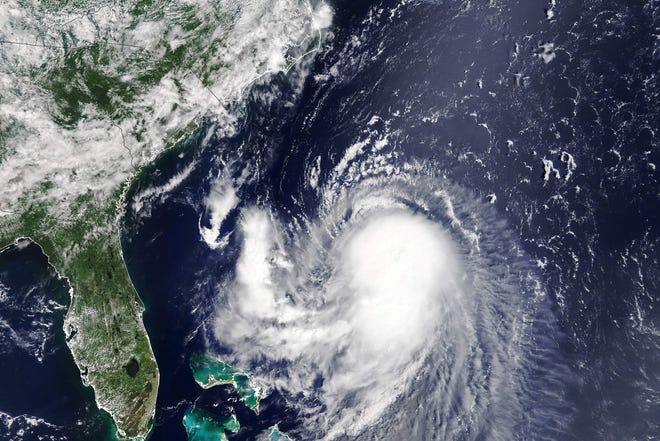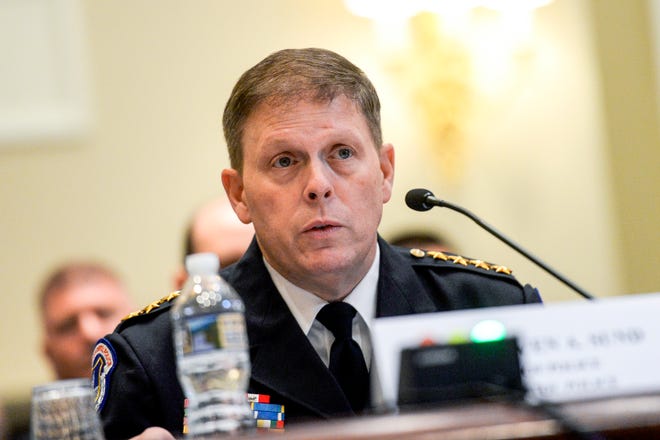
- This is the most serious hurricane risk in New England in 30 years.
- Hurricane and storm surge warnings were in effect for portions of Long Island and southern New England.
- Forecasters said Henri would make landfall at or near hurricane strength on Sunday.
The northeastern U.S. is bracing for its first direct hit from a hurricane in years as Hurricane Henri continued to barrel north Saturday.
The system, which was upgraded to a hurricane with winds of 75 mph as of 2 p.m. Saturday, is forecast to slam into Long Island or southern New England late Saturday or early Sunday at or near hurricane strength, with winds that could approach 80 mph, the National Hurricane Center said.
New York Gov. Andrew Cuomo declared a state of emergency for parts of New York, including Long Island, New York City and Hudson Valley. He pleaded for people to take warnings seriously at a Saturday news conference.
Threatening to bring damaging winds, as much as 8 inches of rain and up to 5 feet of storm surge, Henri could be the first significant hurricane to affect the region in years.
"This is the most serious hurricane risk in New England in 30 years, since Hurricane Bob in 1991," AccuWeather chief meteorologist Jon Porter said. Bob was a Category 2 storm that killed at least 17 people.
Hurricane and storm surge warnings were in effect for portions of Long Island and southern New England, the National Hurricane Center said. Over 5 million people live where a hurricane warning is in place, the National Weather Service reported.
"Preparations to protect life and property should be rushed to completion," the Hurricane Center said.
Tropical storm warnings were also issued for much of southern New England, Long Island and southern New York, including New York City itself. In all, some 35 million people were under tropical storm warnings as of Saturday morning.
Henri was centered Saturday morning about 180 miles east-southeast of Cape Hatteras, North Carolina, and about 465 miles south of Montauk Point, New York. It was moving north-northeast at 14 mph.

The weather service warned of the potential for damaging winds and widespread coastal flooding from Henri, and officials in Massachusetts, Connecticut and New York cautioned that people could lose power for a week or even longer.
Authorities urged people to secure their boats, fuel up their vehicles and stock up on canned goods.
Cuomo said he is deploying 500 members of the state's National Guard and placing swift water rescue teams on standby. He said the state has also deployed 500 national guard members and have 1,000 state police officers on duty in affected areas, as well as FEMA teams.
Cuomo drew ominous parallels between the approaching hurricane and 2012's catastrophic Superstorm Sandy, which killed more than 100 people and created billions of dollars in damage. In New York City, Sandy flooded streets, tunnels and subway lines and caused power outages throughout the city.
Like Sandy, Cuomo said, Henri is a Category 1 storm that is expected to bring wind gusts greater than 75 mph. He said the state may see significant power outages, and heavy rains could mean "creeks turn into raging rivers."
"It's as serious as a heart attack," Cuomo said.
"Hurricanes, floods — they didn't happen in New York," he added. "But they do now."
But he said, unlike Sandy, residents have had less notice ahead of Hurricane Henri because of recent changes in the storm's trajectory.
"So if you have to move, if you have to stock up, if you have to get to higher ground, it has to be today," he said.
Rescuing people who decide to stay in place puts emergency personnel at an unnecessary risk, Cuomo said.
"At the end of the day, it is up to the people of the state to make the right decision," he said. "If you know that you're in an area that tends to flood ... get out of that area now."
Massachusetts Gov. Charlie Baker on Friday urged people vacationing on the Cape to leave well before Henri hits, and those who planned to start vacations there to delay their plans. “We don’t want people to be stuck in traffic on the Cape Cod bridges when the storm is in full force on Sunday,” he said.
“This storm is extremely worrisome,” said Michael Finkelstein, police chief and emergency management director in East Lyme, Connecticut. “We haven’t been down this road in quite a while and there’s no doubt that we and the rest of New England would have some real difficulties with a direct hit from a hurricane.”
Henri (pronounced ahn-REE) will remain offshore of the mid-Atlantic beaches as it moves northward through Saturday. Beaches from Savannah, Georgia, to Atlantic City, New Jersey, can expect some indirect impacts from the storm, including rough surf and the chance of dangerous rip currents.
Grace strikes Mexico a second time
Hurricane Grace crossed over Mexico's Gulf shore as a major Category 3 storm early Saturday, drenching small fishing towns and beach resorts as it made its second landfall in the country in two days.
The storm had lost power while crossing over the Yucatan Peninsula Thursday, swirling through Mexico's main tourist strip, but it rapidly drew in power from the relatively warm Gulf of Mexico as it moved toward the country's mainland.
The Hurricane Center said Grace had maximum sustained winds of 125 mph Saturday when it made landfall about 30 miles south-southeast of Tuxpan. As of 2 p.m., Grace had significantly weakened, heading west-southwest from 35 miles away from Mexico City at 13 mph with maximum sustained winds of 45 mph.
Forecasters said Grace would quickly lose strength as it swirled inland over a mountain range carrying its heavy rains toward the heart of the country, including the Mexico City region. Forecasters said it could drop 6 to 12 inches of rain, with more in a few isolated areas – bringing the threat of flash floods, mudslides and urban flooding.
Contributing: The Associated Press
Source link









